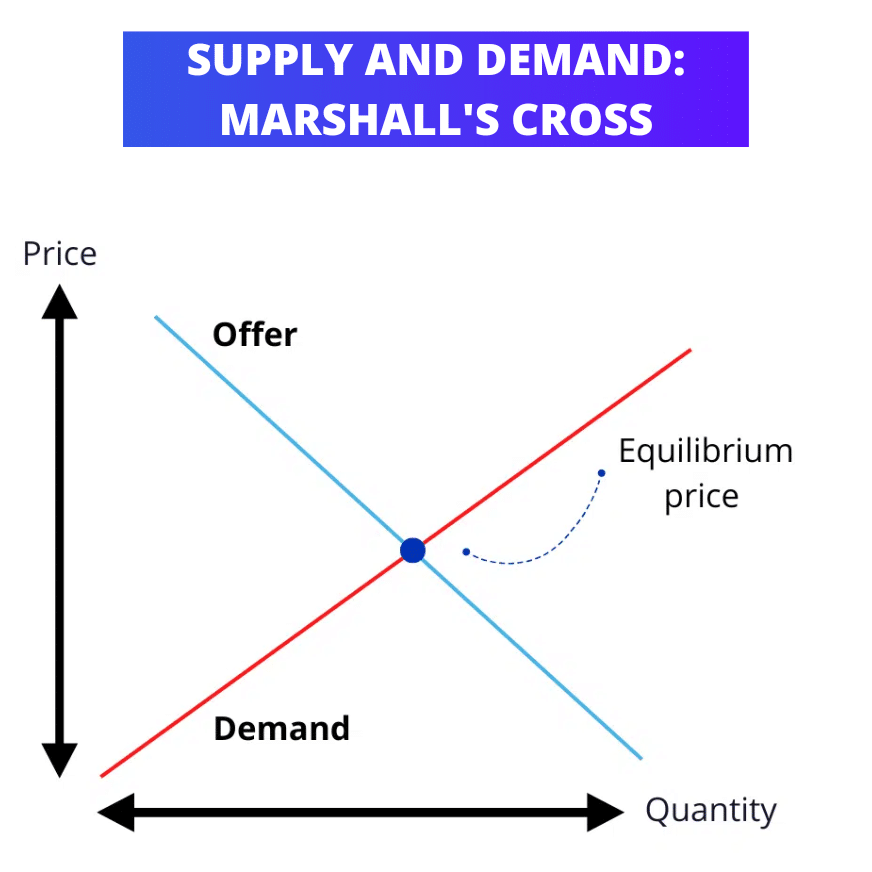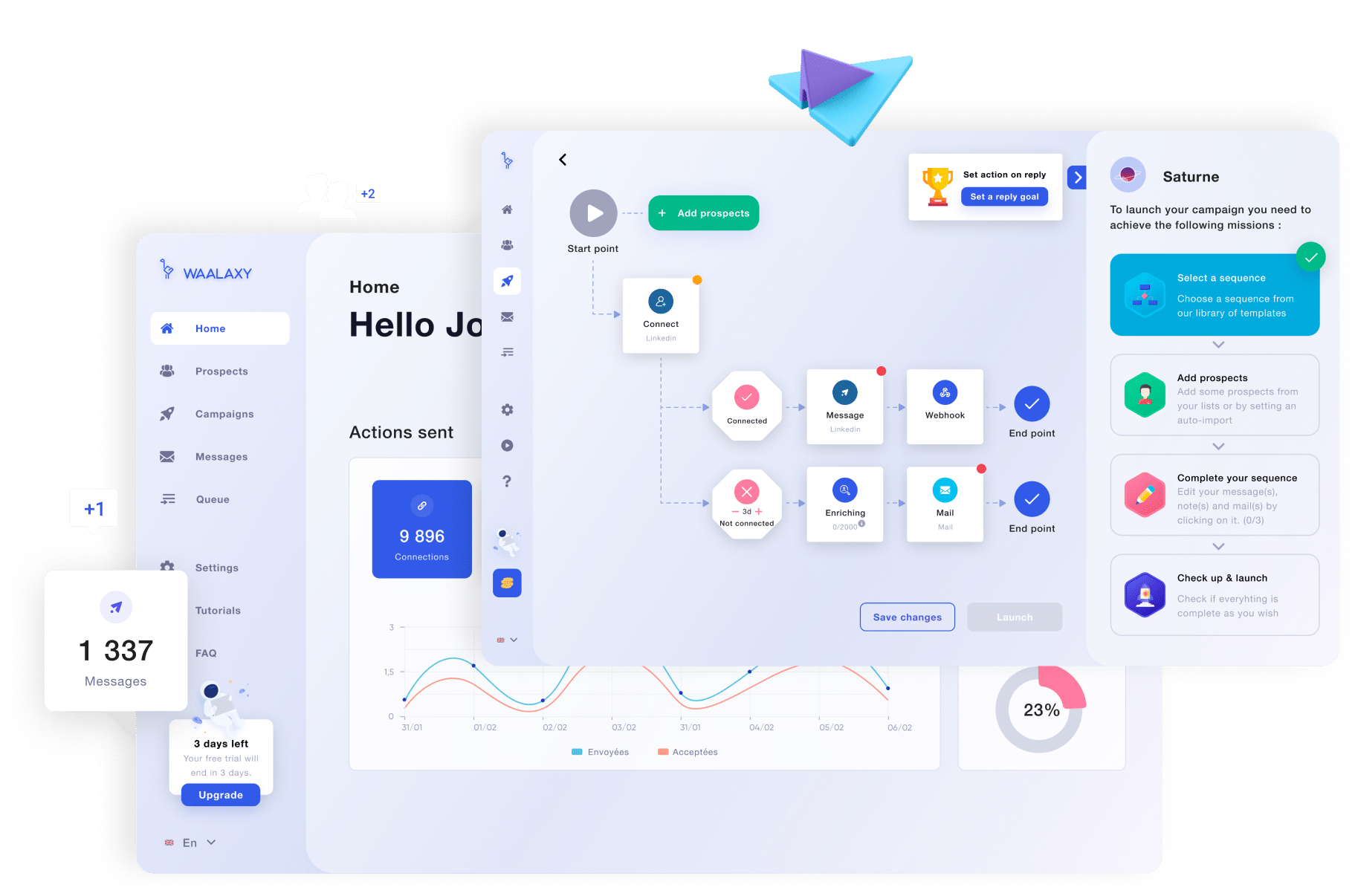Yep, it’s time to talk a little bit about economics. 💰 Don’t be alarmed, we’ll have fun talking about the law of supply and demand. On the agenda of our little article, we will discover:
- A small definition of families
- The law of supply and demand in economics.
- Its limits.
- The concrete applications.
Come on, let’s go! 👣
Law of supply and demand definition
This fundamental concept of economics establishes the relationship between production and consumption in a market. When the demand for a product will increase, the price 💸 of that product tends to increase as well.
This increase in price encourages producers to increase their production to meet this demand and also to maximize their profits. On the other hand, when demand decreases, the price tends to decrease, which can cause producers to reduce their production (and sometimes leave the market 😔).
The law of supply and demand is a powerful force that influences production and consumption choices in goods and services markets. By understanding the mechanisms of this law, firms can make informed decisions about their supply and consumers can make informed choices based on their budgets and preferences.
So now that we’ve seen that, let’s take an in-depth look at the two elements that make up this term.
Supply and Demand Graph
To help you better understand this term, we have prepared a visual element for you.

Supply and demand model
In order to perfect your knowledge, we will also talk a little bit about the shock of supply and demand. But what is it? When there is an unexpected variation in production conditions affecting producers, it is called a supply shock. For example, if there was a severe storm 🌪️ that destroyed a grower’s vegetables, that’s an unanticipated variation that affects production. The same thing can happen on the demand side. Indeed, a demand shock is also an unexpected variation. It can be, for example, an increase in government spending that forces households to spend less.
The supply side
Supply refers to the quantity of goods or services that producers are willing to sell in a given market at a certain price. Producers consider several factors in determining their supply, including the cost of production, labor costs with raw materials, transportation costs, and competition ❌ in the market.
Determine demand
The term “demand” here refers to the quantities of goods or services that consumers are willing to purchase in a given market at a certain price. Demand is influenced by several factors, including income, consumer preferences and tastes, prices of competing products, the availability ✅ of substitute products, advertising campaigns, and changes in market trends. When demand for a product increases, consumers are willing to pay a higher price to obtain that product. You can use demand analyses to understand consumer needs and preferences, adjust your offerings, and set a price accordingly. Fluctuations in demand can also impact your production choices, investment decisions, and marketing strategies.
Law of supply and demand in economics
In the modern economy that we all know, this concept is fundamental. We explain: 👇
- When supply and demand are in equilibrium, they allow for the regulation of prices and production of goods and services in markets.
- These are “opposing forces” that must determine the price and quantity of a product. If supply is greater than demand, prices tend to fall, while if demand is high compared to supply, prices will rise.
➡️ As you can see, the balance between supply and demand is crucial to maintain stable prices and efficient production. But it is also important to encourage innovation and investment in businesses. So far, you have understood that the mechanisms of this law are quite simple. Let’s recap: when demand for a product increases 📈 so producers have an incentive to increase their supply to meet that demand and conversely, when demand decreases, producers can reduce their supply due to a decrease in demand.
Effects on quantity produced
It must be taken into consideration that when demand increases, it must be met 📣 but this can also lead to additional costs in production, increasing the size of the company or even hiring new employees. If there’s a drop in demand, production can be reduced to avoid overstocking and minimize production costs. This may lead to layoffs, reductions in production capacity or, in the worst case, the closure of some plants or facilities.
Effects on resource allocation
Yes, this law also has effects on the allocation of resources in markets. When demand increases, resources are reallocated to the production of that product to meet the demand. This includes increasing production, expanding the output of an industry, or adding new firms to the market. This may result in a reduction in the production of other products or a decrease in the market share of other firms that are not yet able to adapt to the growing demand.
The limits of the law of supply and demand
As you can imagine, not everything is rosy 🦩 in this concept. Although it is a fundamental principle of economics, it also has some limitations ❌. Indeed, the law of supply and demand assumes that markets are perfectly competitive, that is, that all actors have complete information and that production costs are the same for all.
But in reality, there are many factors that can influence the functioning of the market that are not taken into account by the law of supply and demand. For example, the concentration of power in a small number of producers or distributors can lead to a distortion of the market and an imbalance of supply and demand. But this is not the only reason, there are others, and we will talk about them. 👇
Monopoly situations
In monopoly situations, a single supplier controls the supply of a product or service in the market, allowing it to set a higher price 💸 than would be possible in a competitive market. The monopolist is therefore the only seller in the market, which means that he has no other competitive market to force him to offer lower costs in response to lower demand. He can use his market power to maximize his profits by charging higher prices.

This distorts the law of supply and demand because the quantity produced, and the selling price are determined by the “monopolist” rather than by the interaction between supply and demand itself.
Don’t worry, monopoly situations are often regulated by governments to prevent abuse of power and protect the consumer. These same governments can also encourage competition by allowing new competitors to enter the market.
In all cases, it is important to understand that the law of supply and demand can be disrupted in the presence of a monopoly and that measures must be taken to ensure economic efficiency.
Externalities: What is equilibrium price in economics?
Externalities occur when the economic activity of an agent has effects on others that are not taken into account in the decisions of that agent.
In other words, externalities are indirect effects of an economic ⚖️ transaction on stakeholders who are not parties to the transaction. Externalities can have an impact on the law of supply and demand by disturbing the market equilibrium.
For example, a firm that pollutes the environment may cause damage to public health or the environment, which may not be reflected in market prices. The external costs of pollution are therefore not taken into account in the firm’s decisions, which can lead to overproduction and overconsumption of the product in question.
In other cases, they can have positive effects on the market. We will take the example of a beekeeper 🐝 who contributes to the pollination of the surrounding crops, which may not be reflected in the price of honey.
In this case, the external benefits are not factored into the producer’s decisions, which may lead to underproduction and under consumption of the product.
Public goods
Public goods are goods that are characterized by two traits 👇:
- Non-exclusion.
- Non-rivalry.
This will mean that these goods cannot be excluded or denied to anyone, and their consumption by people does not affect the availability of the particular good to others. Examples of public goods include:
- Public infrastructure (such as roads or bridges, for example).
- Schools.
- Our hospitals.
- The air.
- Or water.
The law of supply and demand does not always work effectively for public goods because of their non-exhaustive and non-rival nature.
These goods often have a very strong social demand, but their production and financing are often difficult to ensure because producers cannot benefit directly 😔. Thus, the quantity offered of these goods does not always meet the social demand and can lead to economic inefficiency. As you might expect, the production of public goods often requires government involvement and collective coordination to finance and provide these goods to society.
They can finance public goods through taxes and subsidies or by directly assuming production technology. Effective management of public goods may also require regulation to preserve their quality and long-term availability.
Practical applications of the law of supply and demand examples
We have seen that this law is widely used in economics to understand markets and predict the behavior of customers and producers. It is used to analyze the prices of goods and services and to predict how changes will affect prices. 🤑
Example of the economic principles
A concrete example of the use of the law of supply and demand in economics is the analysis of commodity markets such as gold, oil or wheat. 🌽 Changes in supply such as a production disruption or regulatory changes can have a significant impact on the prices of these commodities.
Example of supply and demand in politics
An example of supply and demand in politics: The supply of improved national security policies stems from a growing public need to protect against the threat of terrorism. 🥷 To meet this demand and win the support of voters, politicians are proposing stronger measures, such as increasing the defense budget.
Example of supply and demand in society
Offer example: A company offers a revolutionary new appliance that makes everyday life easier by automating household tasks. 🤖 The company highlights the benefits of the device, including time saving and increased efficiency.
Example of request: Consumers are looking for practical solutions to simplify their daily lives and increase their productivity. You are interested in this offer and are ready to invest in this gadget to reap the benefits it brings. 💹
What is an example of supply and demand in everyday life?
This can also be used in everyday life to understand how product prices vary with supply and demand. For example, airplane ticket prices vary according to seasonal demand and flight load factors. Fruit and vegetable prices vary according to the harvest, seasonality… 🌬️
Law of supply and demand: The Recap
We have reached the end of the article (well almost) and you have understood that the law of supply and demand was very simple to assimilate. So, you will be able to show off on:
- The definition of the law of supply and demand.
- What it does in economics.
- Its limits.
- How it works in a concrete application.
Frequently asked questions: Supply and demand meaning
Before we leave, we have two more things to perfect your knowledge.
What is the supply and demand curve?
It was an English economist, Alfred Marshall, who introduced this notion. He set up the “Marshall Cross” (the graph we saw at the beginning of this article). He is one of the fathers of neoclassical economics, and he introduced the supply and demand curves.
What is the law of elasticity in supply and demand?
When we talk about elasticity, we are referring to the measurement of the sensitivity of the quantity demanded or offered of a good or service to a variation in its price. Simply put, it will measure 📏 the reaction of buyers and sellers to a change in price.
If the elasticity is high, it means that buyers or sellers are very sensitive to price change and quickly adjust their behavior accordingly. For example, if the price of a product increases, buyers may decide to buy less of it or look for a cheaper substitute, while sellers may decide to offer more of it in the market. This elasticity depends on several factors such as: ⏬
- The availability of substitute products.
- The time during which the price change applies.
- The share of the budget devoted to the product in question.
Now you know all about the law of supply and demand.








